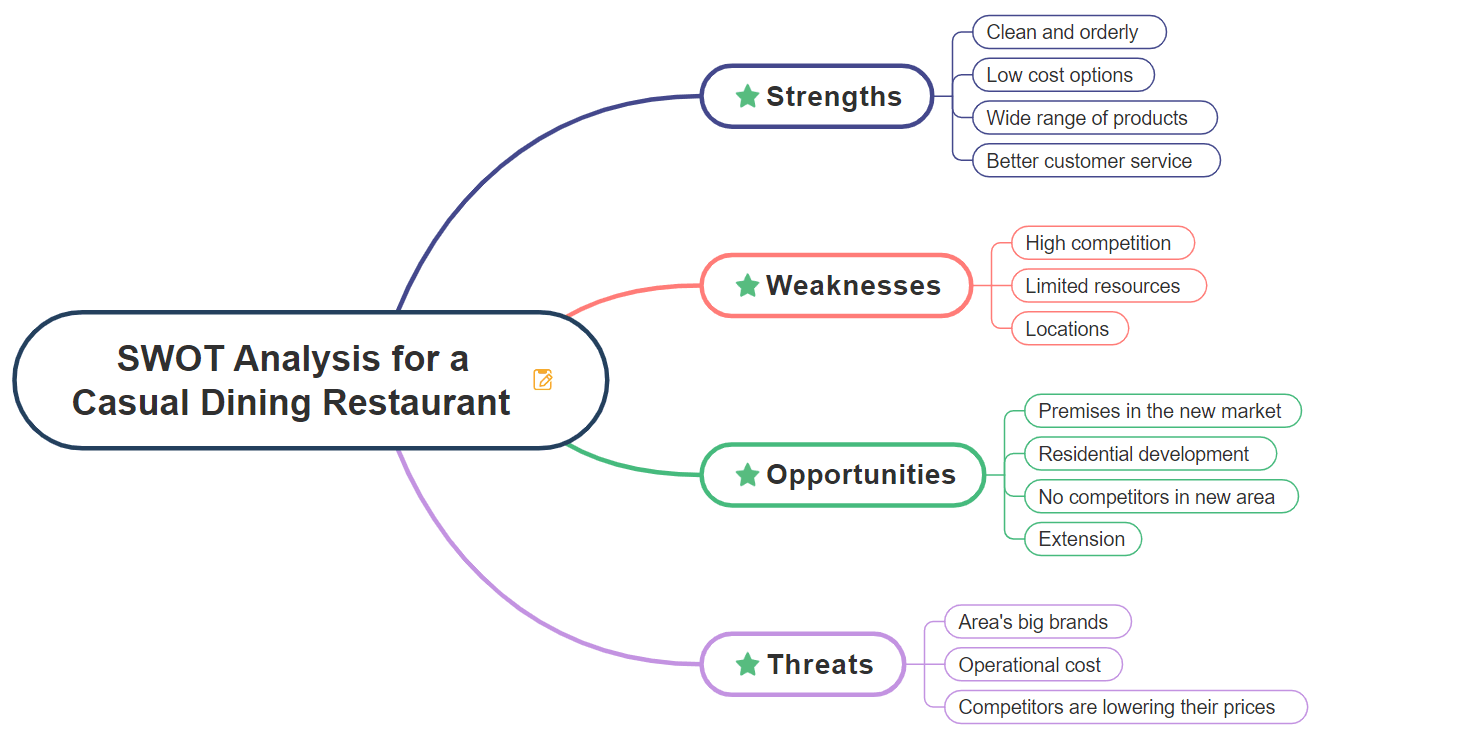Identification of What a SWOT Analysis Is
A SWOT analysis is a clear guide to identifying all that the business is capable of and performs well at. This is especially true for the various activities of a particular business. The analysis will help point out what needs attention and what needs to be improved upon, especially when it comes to the weaknesses. Doing analysis will reveal if there are any new ventures for the business. The analysis will also reduce the risks to the business.
Thus, when the analysis is placed in a clear four-quadrant diagram, it will help identify the strengths, weaknesses, opportunities, and threats (SWOT) of the business. The SWOT analysis of a company example below will point this out. A SWOT analysis is an important activity in any business, small or large. However, it is even more so for small or new businesses.
The four-quadrant diagram will include the Strengths, Weaknesses, Opportunities, and Threats with relevant questions for each. Below is an example of how the diagram can be distributed, with examples of questions for each.
Strengths
For this quadrant, the need is to establish the reason for expansion into a particular area, for example. Some questions that might be relevant here are as follows:
- What are the elements in the business that set it apart from others?
- How competitive is the business in its field?
- Do they have a competitive product to sell?
- What are the strongest skills and assets of the business?
- What resources does the business have?
- Does the business have a geographical advantage?
Weaknesses
This quadrant will attempt to establish what could stand in the way of an expansion of the business.
- What areas need improvement in the business?
- Is the staff or employees well-trained compared to other companies?
- Does the business lack any resources?
- Are the competitors better equipped?
- Does the company have any debt, and how much?
- Are there many complaints?
Opportunities
The quadrant here will evaluate external elements that could provide opportunities for growth and development.
- Can the business fill a gap in the market?
- Would improve packaging help in increasing revenue?
- Would it help if the business provided more staff training?
- Would the business benefit from improved technology?
- Would a geographical change provide more opportunities?
Threats
Here, it is important to identify external factors that could prevent the business from thriving.
- Do current markets threaten the business’s product line?
- Are there potential competitors on the horizon?
- Are there competitors close by?
- Would the increase in rent affect the business location?
- Will governmental regulation have an effect on business?
Not all businesses will have the same set of questions. Every business has to individualize questions so that they pertain to their individual business, as the SWOT analysis example for a small business below will show. The more pertinent the questions in each quadrant, the better the SWOT analysis.
This means that each small business will conduct a SWOT analysis according to its expertise, or product range, as can be seen in the SWOT analysis of a company example below.
Ten Best Examples of SWOT Analysis for Small Businesses
The ten best SWOT analysis examples for a small business can be seen below. These analyses are guidelines for small businesses who need some assistance with doing an analysis.
Casual Dining Restaurant Example
The casual dining restaurant would have its strength in its neatness and cleanliness. Furthermore, it has low cost options, can offer a range of products, has good customer service, and competitive pricing. Weaknesses could be the location, limited resources, and high competition in certain areas. Opportunities could be in new areas where there is no competition, such as new residential areas that can present the absence of competition. The threats are from big businesses, operational costs, and competitors competing by lowering prices.

Small Breweries Example
As an example, the company, Sedibeng Breweries, has a strong emphasis on marketing and an experienced management team. Their weakness is that they are not technologically savvy. Consequently, Internet activity can become difficult, especially as a marketing tool. They also lack the reputation and money of large breweries. This will impede them from competing with bigger breweries. Grabbing opportunities to improve labeling and bottling will aid the business in reaching high-end customers. The threat is that large breweries control supply and distribution, thus cornering the market.

An Example for a Small Online Hat Store
The company, Haley’s Vintage Hats, has its strength in the fifteen-year experience of its founder. The Etsy store makes it possible to have low overheads. The owner replicates original vintage hats. The weaknesses are that she works alone and has no marketing background. The opportunity for the business is that she could hire an intern as an assistant, as well as work with other online vintage sellers. The threats the business faces are potential competitors, lack of vintage fabric supplies, or the Etsy store might crash and become unavailable.

A Medical Device Company
Novoculi’s strength would be in their two FDA-approved novel devices. The major weakness is that they are reliant on funding and have no network of medical device distributors. The opportunities are in the untapped market of laser refractive surgery, which is becoming more popular. The threats are found in other types of eye care, such as LASIK and visual aids, that have a long history.

An Example of a Recycling Company
The strength of Replay Plastics would be centered on the combined experience of the executives. The weakness would be the high cost of building and opening a PET plant. The greatest opportunity is that the plant could produce about 46 million pounds of recycling as well as by-products from it. Threats are around governmental regulation and the need to continuously update recycling solutions. The use of PET bottles might also decline.

Botanical Plant Business Example
Botanical Beauty has its strength in the plants they grow. Its weakness is in a weak reputation in plant growing and the amount of debt it has to enter into at the start. The biggest opportunity would be to build a reputation through relationships with botanical vendors. The threats are that the plants could be affected by the weather, pests, and other larger, more established farms.

Example of a Convenient Food Company
UPer Crust Pies will have location as its biggest strength. It will be based downtown, in Youthtown, have a strong management team, and offer the best alternative to other fast foods. As a weakness, the company will be dependent on external funding, and they have not built a reputation yet. The opportunities are that the city is growing and convenient food, with UPer Crust Pies, is another choice. The threat is that there are similar products with loyal customers. Comparisons in quality could deter customers.

A Food Truck Business Example
A food truck business has its strengths in its mobility, affordability, low start-up costs, and speedy food preparation. The weaknesses are that the menu is often limited, the truck could break down, and sales could also be limited. Opportunities are found in expanding the menu or making it unique, using eco-friendly containers, and finding new suppliers. Threats are that the business can easily be duplicated, customers can change their preferences, and the gas price will increase.

Pub or Bar Example
The strengths of this type of business are that it is a popular type of business, it is often easy to access, it has a high turnover, and it has the potential for a large pool of recruitable staff. Weaknesses could be in the venue size, liquor license limitations, and turnover of staff or management. Opportunities are in the potential to expand (larger premises), product expansion, expanding the brand image, and diversifying the theme. The threats are parking or traffic flow issues, competitors, and societal alcohol issues.

Example of a Café or Coffee Shop
The strength is that a coffee shop can, for example, offer strong brands, premium rates, high quality services, and, therefore, excellent customer service. Its weaknesses are that it is an extremely competitive environment, the services are mostly manual, the data is limited, and it is difficult to come up with a name. Opportunities can be found in expanding the product line, offering loyalty awards, and coming up with innovative techniques. Threats are seen in the low profit margin; maintaining cash flow is difficult, and a market with a sensitivity to high pricing.






